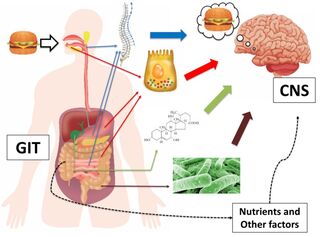Eating Disorders
How We Eat May Be Determined by Our Early Life Experiences
Your relationship to food is neurobiological.
Posted November 11, 2022 Reviewed by Davia Sills
Key points
- There is a wide range of “unhealthy” eating behaviors, and some share features found in diagnosable eating disorders.
- Ambiguity in recognizing unhealthy eating patterns can result in missed treatment and self-improvement opportunities.
- An unbalanced relationship towards food can stem from a neurobiological source.
While eating is an important mechanism of survival, eating styles and habits can dramatically differ between individuals and across cultures. In some people, eating can be compulsive, uncontrollable, or even excessive beyond the healthy dietary need. In fact, there is a wide range of “unhealthy” eating behaviors, and some share features found in diagnosable eating disorders like binge eating. Another set of eating behaviors is marked by compulsions and shares the neuropsychological components of addictive disorders, including craving and persistence despite negative consequences.
Overall ambiguity in recognizing unhealthy eating patterns can result in missed treatment and self-improvement opportunities. In some cases, an eating disorder may be entirely overlooked or mistaken for another condition, such as depression or anxiety. Yet an unbalanced relationship towards food can stem from a neurobiological source. Left unchecked, poor eating habits can have chronic health consequences, including metabolic and cardiovascular disease, weight fluctuations, and social and mental health harm.
Our relationship with food starts early in life.
The modern-day mass production and global distribution of food are not consistent with how humans have evolved in the context of food. Many foods are chemically processed in ways that enable preservation, while other food items are supplemented with sweeteners and various forms of fat. It is accepted that some of the chemical modifications to food play a role in driving unhealthy eating and are highly associated with health problems and weight gain.
Today, more than 2 in 5 American adults are obese, and 1 in 11 is severely obese. The percentage of men who are overweight (34.1 percent) is generally higher than women (27.5 percent), and by current measures, half of the U.S. population will be obese by 2030. Inadequate diet and lack of exercise are the mainstays of weight gain across socioeconomic classes. Inequality in the availability of fresh food items and lifestyle choices are also important contributing factors.
Adolescence is a time period for developing lifelong behavior traits and for forming lifestyle habits. This time is also a period of neurobiological vulnerability for addiction and, interestingly, an especially vulnerable time for weight gain since brain circuits for reward and learning are actively maturing, and the connection between the brain and the gut is still evolving. The neural pathways that connect the brain and gut are essential for signaling fullness or hunger but also link appetite to mood and pleasure. Studies in animal models show that long-term consumption of a high-fat diet activates the brain’s dopamine reward pathway in ways that are similar to addictive drugs such as cocaine. Serotonin, which is known to regulate mood and contribute to appetite, is regulated by food consumption as it is by drugs such as alcohol. Mood disorders, such as depression, are interestingly highly correlated with eating disorders, and adolescence appears to represent a critical period when certain eating behaviors form.

Thus, while adolescence is an excellent time to develop healthy eating and lifestyle habits, the data shows that the food choices of many adolescents in the United States are inconsistent with dietary guidelines. On the whole, adolescent food intake tends to be sparse in fruits and vegetables and high in fat and sugars. Skipping meals is also a concern, as is binge eating.
These poor choices in youth may increase the risk of developing an unhealthy relationship with food within brain pathways for eating and regulation. This process may contribute to unhealthy eating habits, weight gain, and even mood disorders later in life.
References
Witek K, Wydra K, Filip M. A High-Sugar Diet Consumption, Metabolism and Health Impacts with a Focus on the Development of Substance Use Disorder: A Narrative Review. Nutrients. 2022 Jul 18;14(14):2940. doi: 10.3390/nu14142940. PMID: 35889898; PMCID: PMC9323357.
Guleken Z, Uzbay T. Neurobiological and neuropharmacological aspects of food addiction. Neurosci Biobehav Rev. 2022 Aug;139:104760. doi: 10.1016/j.neubiorev.2022.104760. Epub 2022 Jun 30. PMID: 35780976.
Sutton CA, L'Insalata AM, Fazzino TL. Reward sensitivity, eating behavior, and obesity-related outcomes: A systematic review. Physiol Behav. 2022 Aug 1;252:113843. doi: 10.1016/j.physbeh.2022.113843. Epub 2022 May 13. PMID: 35577107.
Kidd C, Loxton NJ. A narrative review of reward sensitivity, rash impulsivity, and food addiction in adolescents. Prog Neuropsychopharmacol Biol Psychiatry. 2021 Jul 13;109:110265. doi: 10.1016/j.pnpbp.2021.110265. Epub 2021 Feb 3. PMID: 33545225.


